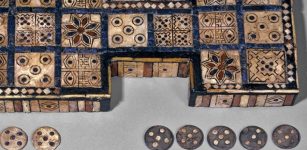Celtic Knot Decorated Bible, Gospels, Celtic Crosses And Symbolized Strength, Love And Continuity Of Life
A. Sutherland - AncientPages.com - The Celts reached a high level of civilization, yet this civilization ceased to exist long ago.
Its rich culture and art survived until modern times, for example, in the form of mysterious and complex patterns and symbols expressed by the Celtic knotwork, which appear almost everywhere in contemporary society.
Left: Tibetan Endless Knot (common form). credit: Dogcow on de.Wikipedia; Right: Design influenced by the illustration in the Lindisfarne Gospels. Credit: User Melian/Wikipedia
Celtic knots are complete loops without any beginning or end; this never-ending style is called pure knots. By using only one thread in their artistic designs, the Celts wanted to express their fundamental belief in the continuity of life and the inseparable connection between life and eternity.
Celtic art was vibrant and colorful, and artists decorated objects of everyday use with various motifs. Based on the Celts' strong belief in symbolism, old legends, and myths, they inspired the culture's artists and their countless knotworks.
The knots vary from simple to very complicated ones, and undoubtedly, they have a deep but not particularly well-known meaning. In addition, there is little written history documenting the purpose of the Celtic knots.
Much later, people began to understand better the true meaning of the Celtic knots displaying the constant intertwining of the spiritual and the physical paths.
Left: Romanesque cross atop the church of St. Susanna, Santiago de Compostela, Galicia. Credit: Froaringus - CC BY-SA 4.0; Right: Cahir Abbey, c. 15th century, credit: Andreas F. Borchert - CC BY-SA 4.0
Modern researchers try to learn more about the symbolism and spirituality behind the Celtic knots based on preserved material evidence and the culture of Ireland, Wales, where Celtic culture has survived.
Old And Modern Use Of Celtic Knots
In earlier times, elaborate designs were predominantly used for decorative purposes. Since the Post-Roman times in Ireland and Britain, the techniques we used as the ornamentation of Christian monuments, Celtic crosses, and manuscripts, such as the 8th-century St. Teilo Gospels, the Book of Kells, and the Lindisfarne Gospels date back before the Christian period.
Additionally, the knots can be found on plates, mugs, garments, and tableware.
How Was It From The Beginning?
Knot patterns first appeared in the third and fourth centuries AD and can be seen in Roman floor mosaics and later as beautiful decorations of Byzantine architecture and Coptic art, Celtic art, Islamic art, Russian book illumination in the Medieval times, Celtic crosses, and to decorate Bible manuscripts.
Before the Christian influence, spirals, step patterns, and other patterns were the most recognizable symbols used by Celtic artists on various objects. The patterns were beautiful and complicated plaits (interwoven cords), which predated knotwork designs in many cultures worldwide.
Example of the plaited knot. Source1; Source2
Gradually the Celtic masters began to use beautiful flowing forms and lines instead of strict symmetry. As a result, unique patterns were created.
True knotwork (the term describing broken and reconnected plait work) appeared in northern Italy and southern Gaul in the 7th century before it spread to Ireland, where it was prevalent among the Picts, Northumbrians, and others.
A British archaeologist, Romilly Allen(1847 - 1907), has identified eight elementary knots, which form the basis of nearly all the interlaced patterns in Celtic decorative art.
In modern times Celtic art is popularly thought of in terms of national identity, specifically Irish, Scottish, or Welsh.
Endless Knot – An Important Cultural Marker
One of the most important of the Celtic knot designs, there is especially one - 'endless knot,' which has many different interpretations in different cultures, including Celtic, Chinese, and Tibetan Buddhism.
The 'endless knot,' an important cultural marker, can be drawn without the pen leaving the paper. It symbolizes an uninterrupted life cycle, compassion, and wisdom combined, male and female, night and day. It also represents the need to unite material matters with spiritual ones. Since the knot has no beginning and no end, comparisons can be drawn with the circle.
In later times in Ireland, where Celtic culture survived the longest, the scribes used the endless knot frequently, as it was considered an ideal symbol of divine infinity and diversity.
Written by – A. Sutherland - AncientPages.com Senior Staff Writer
Updated on February 26, 2023
Copyright © AncientPages.com All rights reserved. This material may not be published, broadcast, rewritten or redistributed in whole or part without the express written permission of AncientPages.com
Expand for referencesReferences:
Romilly Allen, Celtic Art In Pagan and Christian Times
Sandison, D. The Art of the Celts
More From Ancient Pages
-
 Indian Black Earth And Biodiversity Of The Amazon – New Study
Archaeology | Jun 24, 2020
Indian Black Earth And Biodiversity Of The Amazon – New Study
Archaeology | Jun 24, 2020 -
 On This Day In History: The Great Fire Of London – On July 10, 1212
News | Jul 10, 2016
On This Day In History: The Great Fire Of London – On July 10, 1212
News | Jul 10, 2016 -
 Mystery Of The Ancient Reptilian Gods Remains A Complex Subject – Alien Worlds – Part 2
Ancient Mysteries | Feb 9, 2022
Mystery Of The Ancient Reptilian Gods Remains A Complex Subject – Alien Worlds – Part 2
Ancient Mysteries | Feb 9, 2022 -
 On This Day In History: Julius Caesar Defeated “Pompey The Great” At Pharsalus – On August 9, 48 BC
News | Aug 9, 2016
On This Day In History: Julius Caesar Defeated “Pompey The Great” At Pharsalus – On August 9, 48 BC
News | Aug 9, 2016 -
 How Can AI Affect Human Evolution? Predicting Changes In Brain Size And Social Behaviors
Evolution | Nov 22, 2024
How Can AI Affect Human Evolution? Predicting Changes In Brain Size And Social Behaviors
Evolution | Nov 22, 2024 -
 Deciphered Dead Sea Scroll Reveals Secret Calendar And Two Events Not Mentioned In The Bible
Archaeology | Jan 23, 2018
Deciphered Dead Sea Scroll Reveals Secret Calendar And Two Events Not Mentioned In The Bible
Archaeology | Jan 23, 2018 -
 Royal Game Of Ur – One Of The Oldest Game Boards Discovered
Ancient History Facts | Feb 3, 2016
Royal Game Of Ur – One Of The Oldest Game Boards Discovered
Ancient History Facts | Feb 3, 2016 -
 On This Day In History: Astronomer John Couch Adams And The Discovery Of Planet Neptune – On July 3, 1841
News | Jul 3, 2016
On This Day In History: Astronomer John Couch Adams And The Discovery Of Planet Neptune – On July 3, 1841
News | Jul 3, 2016 -
 Death And Afterlife In Ancient Egyptian Beliefs – Death As Transition To Another Reality
Featured Stories | May 28, 2018
Death And Afterlife In Ancient Egyptian Beliefs – Death As Transition To Another Reality
Featured Stories | May 28, 2018 -
 Largest Ever Recorded Ancient Petroglyphs Found In Venezuela – Mapped
Archaeology | Dec 10, 2017
Largest Ever Recorded Ancient Petroglyphs Found In Venezuela – Mapped
Archaeology | Dec 10, 2017 -
 Unique Page From Rare Illuminated Manuscript And Thousands Of Treasures Found Under The Floor Of Oxburgh Hall
Archaeology | Aug 18, 2020
Unique Page From Rare Illuminated Manuscript And Thousands Of Treasures Found Under The Floor Of Oxburgh Hall
Archaeology | Aug 18, 2020 -
 Huge Gallo-Roman Amphitheater Of Saintes Will Be Saved For Future Generations – New Project Started
News | Jan 23, 2021
Huge Gallo-Roman Amphitheater Of Saintes Will Be Saved For Future Generations – New Project Started
News | Jan 23, 2021 -
 Ancient Egyptians Were Familiar With Advanced Ink Technology 2,000 Years Ago – Copper Papyri Reveals
Ancient Technology | Nov 13, 2017
Ancient Egyptians Were Familiar With Advanced Ink Technology 2,000 Years Ago – Copper Papyri Reveals
Ancient Technology | Nov 13, 2017 -
 Trees Are Deeply Rooted In Beliefs And Cultural Traditions Of Ancient People Around The World
Featured Stories | Feb 18, 2018
Trees Are Deeply Rooted In Beliefs And Cultural Traditions Of Ancient People Around The World
Featured Stories | Feb 18, 2018 -
 On This Day In History: Battle of Devil’s Hole Was Fought – On Sep 14, 1763
News | Sep 14, 2016
On This Day In History: Battle of Devil’s Hole Was Fought – On Sep 14, 1763
News | Sep 14, 2016 -
 Ancient Greco-Roman Amphora Workshop Discovered In Alexandria, Egypt
Archaeology | Apr 17, 2022
Ancient Greco-Roman Amphora Workshop Discovered In Alexandria, Egypt
Archaeology | Apr 17, 2022 -
 Surprising Discovery: Massive Cemetery Built 5,000 Years Ago Near Lake Turkana, Kenya
Archaeology | Aug 24, 2018
Surprising Discovery: Massive Cemetery Built 5,000 Years Ago Near Lake Turkana, Kenya
Archaeology | Aug 24, 2018 -
 What America’s First Board Game Can Teach Us About The Aspirations Of A Young Nation
Featured Stories | Jun 6, 2024
What America’s First Board Game Can Teach Us About The Aspirations Of A Young Nation
Featured Stories | Jun 6, 2024 -
 Utsuro Bune: Ancient Extraterrestrial Encounter With A ‘Hollow Ship’ And An Alien Visitor
Featured Stories | Jun 11, 2020
Utsuro Bune: Ancient Extraterrestrial Encounter With A ‘Hollow Ship’ And An Alien Visitor
Featured Stories | Jun 11, 2020 -
 World’s Oldest Dictionaries Are 4,500-Year-Old Cuneiform Tablets Discovered In Ebla
Ancient History Facts | Aug 19, 2016
World’s Oldest Dictionaries Are 4,500-Year-Old Cuneiform Tablets Discovered In Ebla
Ancient History Facts | Aug 19, 2016



